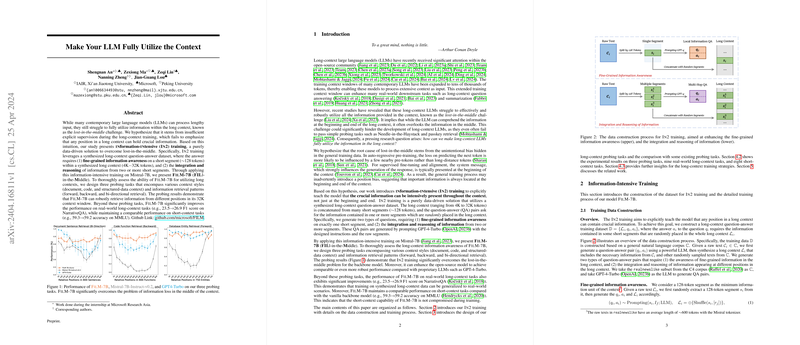Enhancing Information Utilization in LLMs with Information-Intensive Training
Introduction
The challenges associated with managing long-context information in LLMs have been a notable area of focus in recent research. Traditional training methods often lead to models that perform well with information at the beginning or the end of a context but miss critical details in the middle—a phenomenon referred to as the "lost-in-the-middle" issue. Our paper introduces Information-Intensive (In2) training to address this challenge, focusing on enhancing model capability to handle and integrate information throughout extensive text lengths effectively.
Methodology
Data Construction for In2 Training
The In2 training model leverages a synthesized dataset tailored to improve the model's interaction with long-context information. This dataset promotes:
- Fine-grained information awareness: Crafting training pairs that focus on details within a specific segment of the text.
- Integration and reasoning across multiple segments: Formulating queries that require synthesizing information from multiple text segments, enhancing the model's ability to integrate and reason over dispersed textual information.
Technical Training Details
Our experimental setup involves fine-tuning a Mistral-7B model using the generated dataset in a setting that mimics real-world applications. The model, rebranded as FilM-7B (Fill-in-the-Middle), underwent rigorous training processes to maximize its capacity for utilizing extensive text inputs effectively.
Performance Evaluations
Probing Tasks
We designed a set of probing tasks—spanning various context styles (document, code, structured-data) and information retrieval patterns (forward, backward, bi-directional)—to rigorously evaluate FilM-7B's performance across diverse scenarios. Detailed investigations show a significant reduction in the "lost-in-the-middle" issue, with FilM-7B demonstrating robust information retrieval capabilities across all parts of the context window.
Applying to Real-world Tasks
Highlighted results include improvements on long-context benchmarks like NarrativeQA, where FilM-7B notably outperforms existing models with an increased F1 score from 23.5 to 26.9. These results affirm the model's enhanced ability not only in narrowly defined test conditions but also in broader, practical text-handling applications.
Implications on Short-context Tasks
Importantly, our approach maintains comparable performance on short-context tasks, ensuring that enhancements in handling longer texts do not detract from the model’s capabilities in shorter scenarios.
Theoretical and Practical Implications
The integration of FilM-7B could have far-reaching implications, particularly in fields requiring detailed analysis of lengthy documents, such as legal reviews, lengthy academic article summarization, and extensive technical manual interpretation. Theoretically, this research pushes forward our understanding of deep learning architectures, stressing the importance of tailored data training sets in overcoming specific neural network training challenges.
Future Research Directions
Continued advancements could explore further optimization of training datasets and expanding the model’s proficiency to more complex or less structured long-context data types. Additional studies might also delve into refining model architectures to enhance processing efficiencies for extremely long texts without requiring proportionate increases in computational resources.
Conclusion
This paper signifies a step forward in enhancing LLMs' proficiency with long texts. By focusing on the specific challenges of middle-text information loss and creating a targeted training approach, we can significantly expand the practical applications and effectiveness of LLMs across a range of disciplines and uses.
